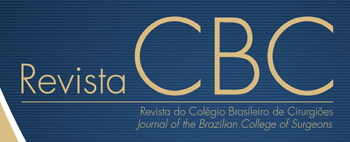Resumo em Português:
OBJETIVO: Comparar o uso das soluções orais de manitol a 10% e de bifosfato de sódio no preparo mecânico do cólon quanto a qualidade da limpeza, a tolerabilidade e as alterações hidroeletrolíticas e da osmolaridade plasmática. MÉTODO: Foram analisados 60 pacientes de modo randomizado, duplo-cego e prospectivo, com indicação de colonoscopia. A qualidade da limpeza intestinal foi analisada pelo examinador através da classificação de Beck. A tolerabilidade à ingestão baseou-se na pesquisa do gosto, presença ou não de desconforto, aparecimento de efeitos adversos e a quantidade da solução ingerida. Foram dosados o sódio, potássio, cálcio, magnésio, fósforo, uréia, creatinina, glicose, hematócrito, hemoglobina e calculado a osmolaridade plasmática, antes e após a ingestão da solução oral de preparo inestinal. RESULTADOS: Ambas as soluções atingiram qualidade de preparo classificado como bom ou superior em mais de 80% dos pacientes. O uso do bifosfato de sódio determinou menor desconforto e melhor tolerância, apesar de não ter sido superior ao manitol quanto à análise do gosto e presença de efeitos adversos. O bifosfato induziu ao aumento e o manitol a uma redução da osmolaridade, reflexo do que ocorreu com o sódio plasmático nos dois grupos respectivamente. O bifosfato ainda determinou alteração significativa dos níveis séricos de fósforo, cálcio, magnésio e potássio, sem repercussões clínicas. CONCLUSÃO: Ambos os tipos de preparo intestinal determinaram qualidade de limpeza adequada. O bifosfato de sódio, apesar de melhor tolerado, determina maior quantidade de alterações hidroeletrolíticas.
Resumo em Inglês:
BACKGROUND: To compare the use of sodium biphosphate and 10% mannitol solutions for mechanical bowel preparation in terms of cleansing quality, tolerability, disorder in water and electrolyte balance, and plasma osmolality. METHOD: Sixty patients who had been referred for colonoscopy were analyzed in a randomized, double-blind, prospective study. The quality of bowel cleansing was analyzed by the examiner using Beck's classification. Ingestion tolerability was established by investigating taste, whether the patient felt any discomfort or not, the development of adverse effects and the amount of solution ingested. The following measurements were made before and after ingestion of the oral bowel preparation solution: sodium, potassium, calcium, magnesium, phosphorus, urea, creatinine, glucose, hematocrit, hemoglobin and plasma osmolality. RESULTS: Both solutions resulted in bowel preparations that were classified as good or superior in over 80% of the patients. The use of sodium biphosphate resulted in less discomfort and better tolerance, although it was not superior to mannitol in terms of taste or the presence of adverse effects. Sodium biphosphate led to an increase, and mannitol to a decrease, in osmolality, reflecting the changes in plasma sodium in both groups. The former also resulted in a significant measurement change in serum phosphorus, calcium, magnesium and potassium levels, without any clinical repercussions. CONCLUSION: Both types of bowel preparation resulted in adequate cleansing. Sodium biphosphate, although better tolerated, leads to more alterations in water and electrolyte balance.
